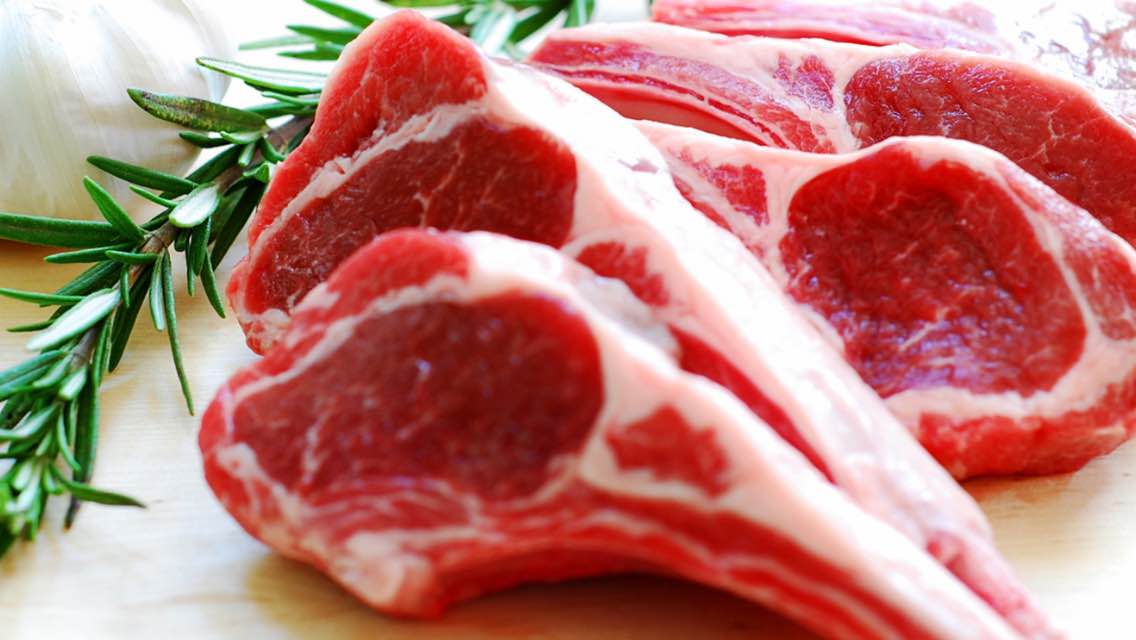Meat is important for health. This isn’t to say that vegetarians and vegans who avoid meat are unhealthy. And it’s not to say someone cannot live well and be healthy — or even be healthier than most Americans — without meat.
In fact, it is not a statement about anyone who chooses to not eat meat. There are many compelling reasons people choose to avoid meat that have nothing to do with nutrition, and this post does not offer an argument against any of those points.
Rather, stating that meat matters for health simply notes that animal flesh has potent health benefits that are more difficult to obtain from other food sources without incurring other, less beneficial physiological effects. This is particularly true when an individual’s diet is solely plant-based, but we’ll get to that shortly.
First, a few caveats — after all, this is a complicated, even hot-button issue:
- A healthy diet (whether it includes meat or not) needs to include a plethora of produce. A well-designed non-meat-eating diet and a well-designed meat-eating diet actually share more commonalities than differences.
- Any well-designed diet eliminates or minimizes highly processed food items, added sugars, and synthetic food additives.
- The sources of meat matter. Animals raised on their native diet in environments as close to their natural habitat as possible (compared to factory-farmed animals) are usually healthier and are thus better sources of nutrition.
- In the points that follow, “meat” refers to animal proteins obtained from animals that consumed their biologically natural diet (e.g. grass-fed beef). It excludes artificially processed or chemically preserved animal proteins.
All that being said, let’s get to the “meat” of the issue, shall we? (Pun intended!)
1. Meat is nutrient dense.
There are a few ways to evaluate nutritional density, but meat performs quite well whether it’s nutrients per calorie or nutrients per 100 gram serving. Compare a 3.5-ounce portion of grass-fed ground beef to the same weight of cooked peas or 3.5 ounces of sprouted wheat (select the 100 gram serving size portion — roughly equal to 3.5 ounces).
Most notably, meat offers slight anti-inflammatory properties and no glycemic load, which means it doesn’t have a negative effect on blood-sugar balance. The wheat and pea examples note a higher glycemic load and, particularly in the case of the wheat, a more inflammatory effect.
The meat example also has a positive balance of omega-3 fatty acids compared to omega-6 fats, making it an ideal food source to support mood, brain function, and cell-membrane health.
Additionally, the minerals contained in the meat are more bioavailable than the minerals found in the grain example, which means they are more easily absorbed than when eaten along with the phytic acid and lectins that are found in grains or legumes.
Long-time “vegan-advocates-turned-omnivores” Denise Minger, Lierre Keith, and Kristen Suzanne have recently spoken about their experiences living on the highest-quality, non-animal foods for years and why they still ended up with diminished health due to often unavoidable nutrient deficits.
2. Protein is an “obligate” nutrient — and meat is an efficient source of protein.
“Obligate” means biologically necessary, and efficiency matters to obtain enough. In order to consume adequate protein (since we can also assimilate protein from non-animal sources), most active or aging adults need to aim for at least 1.0 to 1.2 grams of protein per kilogram of body weight per day. For those aiming for optimal health and performance, the needs are higher at 1.4 to 2.0 grams per kilogram, according to the International Society of Sports Nutrition.
Just for fun, take your body weight in pounds and divide it by 2.2 — this is how many kilograms of mass you have. Now, multiply that number by 2, and you’ll have a target for how many grams of protein you may have to consume daily to perform at your best.
If a 160-pound person tried to achieve an intake target of 145 grams with only non-meat sources of protein, it would take just over 9 cups of beans per day (while also contributing almost 2,000 calories).
While it’s possibleto get adequate protein from non-animal sources, it’s not probable for many people. Without adequate protein, one cannot build and maintain lean muscle, blood cells, or hormones properly.
3. Meat may be your only non-supplement source of certain nutrients.
Vitamins A (retinol), B12, and D, cholesterol, creatine, carnosine, and the most useful forms of omega-3s — DHA (docosahexaenoic acid) and EPA (eicosapentaenoic acid) — can only be obtained in appreciable amounts from animal sources. Organ meats are the most beneficial. The lack of such nutrients over time can have devastating effects on brain function and development, bone formation, and overall health.
For example, pre-formed vitamin A (retinol) from animal sources (e.g., liver and eggs) is critical for proper development and maintenance of vision, skin, mineralization of teeth, and bone growth.
Vitamin B12, a critical nutrient for blood-cell and DNA formation, as well as energy and muscle strength, has been shown to be deficient in a large percentage of non-meat eaters who aren’t supplementing daily with this nutrient.
Many of us don’t get enough sun throughout the year to produce adequate vitamin D. In terms of food sources, vitamin D is found mostly in certain animal foods or processed foods that are fortified with it. Without adequate vitamin D, immune function, cell growth, glucose regulation, inflammation response, calcium absorption, mood, and hormone balance can drift off course.
On a related note, cholesterol is only available in animal foods; it is also the precursor that gives us the ability to synthesize our own vitamin D when we get enough sunlight. While we produce most of the cholesterol in our bodies (we only absorb about 25 percent of dietary cholesterol), eating cholesterol from animal foods (particularly fatty cuts of meat) may have advantages. These benefits include healthier sex-hormone production, better maintenance of DHEA-sulfate levels (known as an anti-aging hormone in many circles), and generally healthier cell membrane integrity.
Creatine, like cholesterol, is made in the body, but is also readily available through raw or lightly cooked animal meats and fatty fish; it is not available in any appreciable quantities from plants.
Creatine is good for more than just boosting athletic performance or reducing recovery times between bouts of high-intensity exercise: Adequate creatine stores may also support heart-failure patients’ recovery efforts and may have considerable value for those with neuromuscular disorders like muscular dystrophy or Parkinson’s.
EPA and DHA are animal sources of omega-3 fatty acids and have been shown to be superior sources for these essential nutrients compared to plant sources containing alpha-linoleic-acid (ALA).
Finally, carnosine is a potent antioxidant that is vital to protecting us against age-related wear and tear. It can only be obtained in beneficial doses from animal foods.
4. Your aging bones have much to gain from meat.
The old and once-common recommendation to limit meat intake to avoid de-mineralization of bone is no longer considered accurate. In fact, going meatless may actually decrease bone integrity as we age.
The best available evidence supports maintaining high protein intakes from high-quality sources throughout the lifespan. Recent research notes that it may be important to increase protein intake the older we get.
5. Meat’s fat content actually supports health.
Many benefits of consuming animal sources may actually come from the accompanying fat — yes, even the saturated kind. Saturated fats, common in meat sources, are important components of hormone precursors and synthesis. They’re actually great sources of energy for both brain and organ function and may be utilized by working muscle tissues as well.
6. Meat promotes muscle growth and maintenance.
Modest consumption of meat — 113 grams containing about 30 grams of protein — every few hours is one of the best ways to stimulate muscle-tissue synthesis. The high biologic value of the amino acids in animal foods makes them an optimal source of essential amino acids to support muscle growth, maintenance, and repair.
7. Animal proteins are tasty and satisfying — and support positive mood and brain health.
The satiety and thermic effect of high-protein foods have been shown to support weight loss. This suggests meat-inclusive dietary protocols may offer a suitable way to achieve lasting weight-loss success.
The “A to Z Weight Loss Study” stunned even its lead researcher (a life-long vegetarian) due to the unexpected results he reviewed here. The groups following diets that included animal proteins not only had remarkable weight-loss results and improvements to several health markers, they also appeared to have some of the best long-term adherence.
Perhaps the ability to enjoy “ad lib” amounts of protein (including fat-rich animal foods) and high-fiber, low-carbohydrate vegetables, without the need to count calories, paved the way for adherence and success in the lowest carb, highest protein group.
Additional research needs to be done to verify contributing reasons behind the results. Nonetheless, it’s suggestive for those who want to lose weight, stay satisfied, and gain health.
Wrapping It Up
While meat certainly is not the only source of protein and other essential nutrients, it is an optimal source for many of them. It’s important to remember, though, that meat’s full nutrient profile is affected by the source animal’s diet. Choosing pastured poultry or grass-fed beef offers the ideal (and natural) nutritional profile.
Some individuals may choose to avoid consuming animal flesh for protein, but include other animal sources such as eggs, cheese, milk, yogurt, or protein powders like whey or casein. This is a suitable way to ensure high-biologic value protein adequacy.
If you choose not to consume any animal protein, we recommend the following non-animal quality sources, including the occasional use of whole, organic (non-genetically modified) soy like tofu, edamame, miso, or tempeh.
Most vegetarians and vegans may also want to also consider supplementing with a high-quality plant-based protein to be sure they get adequate protein, as well as creatine (which is vegan).
Ultimately, it’s important to find a balance of nourishment that makes you feel your best and function at your best.
References
Campbell B, Kreider RB, Ziegenfuss T, La Bounty P, Roberts M, Burke D, Landis J, Lopez H, Antonio J: International Society of Sports Nutrition position stand: protein and exercise. J Int Soc Sports Nutr 2007, 4:8.
Pawlak R, Parrott SJ, Cullum-Dugan D, Lucus D. How prevalent is vitamin B(12) deficiency among vegetarians? Nutr Rev. 2013 Feb;71(2):110-7.
Buford TW, Kreider RB, Stout JR, Greenwood M, Campbell B, Spano M, Ziegenfuss T, Lopez H, Landis J, Antonio J: International Society of Sports Nutrition position stand: creatine supplementation and exercise. J Int Soc Sports Nutr 2007, 4:6.
Reddy VP, Garrett MR, Perry G, Smith MA. Carnosine: a versatile antioxidant and antiglycating agent. Sci Aging Knowledge Environ. 2005 May 4;2005(18):pe12.
Gerster, H. Can adults adequately convert alpha-linolenic acid (18:3n-3) to eicosapentaenoic acid (20:5n-3) and docosahexaenoic acid (22:6n-3) Int J Vitam Nutr Res. 1998;68(3):159-73.
Kerstetter JE, Kenny AM, Insogna KL. Dietary protein and skeletal health: a review of recent human research. Curr Opin Lipidol. 2011 Feb;22(1):16-20.
Symons TB, Sheffield-Moore M, Wolfe RR, Paddon-Jones D. A moderate serving of high-quality protein maximally stimulates skeletal muscle protein synthesis in young and elderly subjects. J Am Diet Assoc. 2009 Sep;109(9):1582-6.
Gardner CD, Kiazand A, Alhassan S, et al. Comparison of the Atkins, Zone, Ornish, and LEARN Diets for Change in Weight and Related Risk Factors Among Overweight Premenopausal Women: The A TO Z Weight Loss Study: A Randomized Trial. JAMA. 2007;297(9):969-977.
Alexander DD, Mink PJ, Cushing CA, Sceurman B. A review and meta-analysis of prospective studies of red and processed meat intake and prostate cancer. Nutr J. 2010;9:50. Published 2010 Nov 2. doi:10.1186/1475-2891-9-50
Alexander DD, Weed DL, Cushing CA, Lowe KA. Meta-analysis of prospective studies of red meat consumption and colorectal cancer. Eur J Cancer Prev. 2011;20(4):293-307. doi:10.1097/CEJ.0b013e328345f985




